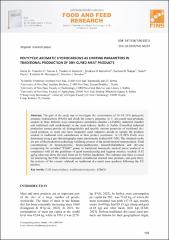Polycyclic aromatic hydrocarbons as limiting parameters in traditional production of dry-cured meat products

View/
Date
2024Author
Vranešević, Jelena
Vidaković Knežević, Suzana
Kartalović, Brankica
Škaljac, Snežana
Plavša, Nada
Mastanjević, Krešimir
Novakov, Nikolina
Metadata
Show full item recordAbstract
The goal of the study was to investigate the concentration of 16 US EPA polycyclic
aromatic hydrocarbons (PAHs) and check the sensory properties in 11 dry-cured meat products,
smoked in three different ways (atmospheric simulation chamber (ATMOS), industrial chamber
and traditional craft smokehouse) in one meat industry facility in Serbia. Controlled industrial
production cannot provide all distinguishable and specific sensory properties of traditional drycured
products, so more and more frequently meat industries decide to include the products
smoked in traditional craft smokehouses in their product assortment. 16 US EPA PAHs were
determined using a gas chromatography-mass spectrometry method (GC-MS). The obtained results
are part of the production technology validating process of the tested smoked meat products. Total
concentrations of benzo(a)pyrene, benzo(a)anthracene, benzo(b)fluranthene and chrysene
(comprising the so-called “PAH4” group) in traditional homemade smoked bacon produced in
compliance with all the guidelines of good manufacturing and hygiene practice, reached 15.82
μg/kg what was above the legal limits set by Serbian legislation. This indicates that there is a need
for monitoring the PAH content compounds in traditional smoked meat products, and quite likely
the revision of the current rulebook on traditional dry-cured meat products following the EU
practice.
